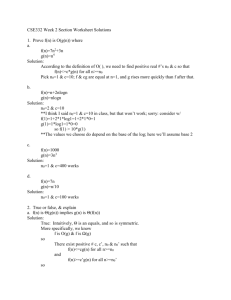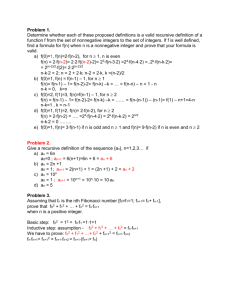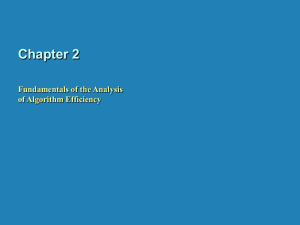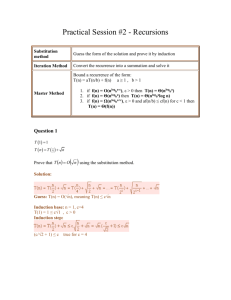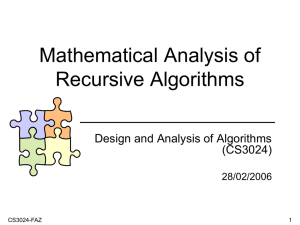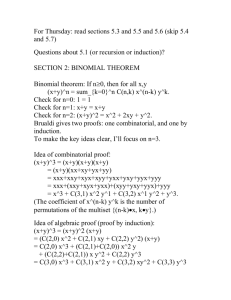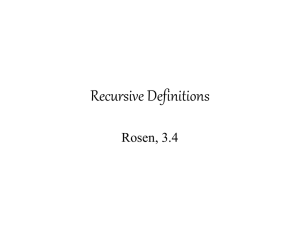X10c
advertisement
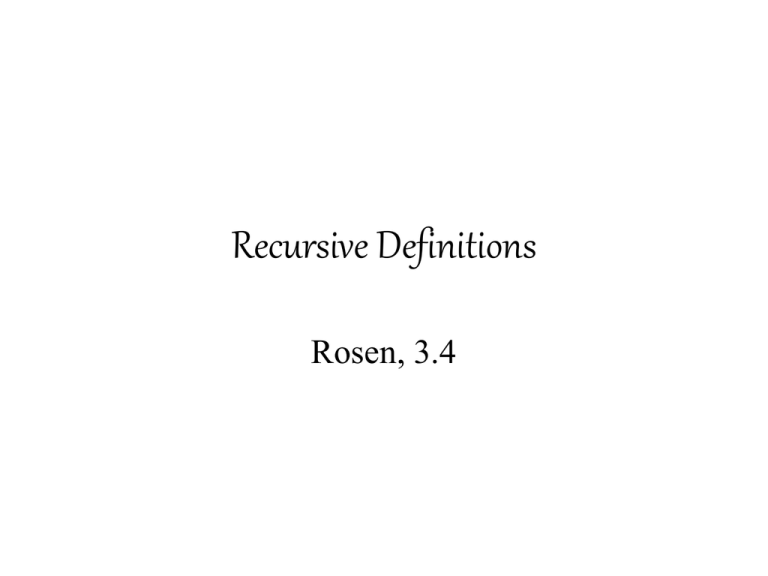
Recursive Definitions
Rosen, 3.4
Recursive (or inductive) Definitions
• Sometimes easier to define an object in
terms of itself.
• This process is called recursion.
– Sequences
• {s0,s1,s2, …} defined by s0 = a and sn = 2sn-1 + b for
constants a and b and n Z+
– Sets
• 3 S and x+y S if xS and yS
– Functions
• Example: f(n) = 2n, f(n) = 2f(n-1) and f(0) = 1
Recursively Defined Functions
To define a function with the set of
nonnegative integers as its domain
1. Specify the value of the function at zero
(or sometimes, it first k terms).
2. Give a rule for finding its value at an
integer from its values at smaller integers.
Examples of Recursively Defined
Functions
• Factorial Function n!
n! = n(n-1)(n-2)….(1)
f(0) = 1, f(n) = n(f(n-1))
• an
f(0) = 1, f(n+1) = f(n)*a
• Fibonacci Numbers
f0=0, f1=1, f n+1 = fn + f n-1
{0,1,1,2,3,5,8,13,...}
Prove that the nth term in the Fibonacci
n 2
sequence is 1 f i when n2
i 0
Induction Proof:
2 2
Basic Step: Let n = 2, then f2 = 1 =
1 f i =1+0
i 0
Inductive Step: Consider k2 and assume that the expression is
true for 2 n k. We must show
k1 that the expression is true for
(1 f i )
n = k+1, i.e., that fk+1
i 0
fk+1
= fk +fk-1 by definition
k 2
(1 f i ) f k 1
i 0
by the inductive hypothesis
Fibonacci Proof (cont.)
k 2
(1 f i ) f k 1
i 0
k1
(1 f i )
i 0
Since f2 is true and [fn is true for 2 n k fk+1] is
true, then fn is true for all positive integers n2.
Recursively Defined Set Example
Let the set S be defined recursively as 3 S
and x+y S if xS and yS.
Prove that S is equal to the set of positive
integers divisible by 3 (set A).
Proof:
To show that S = A, we must show that AS
and that SA.
Recursive Set Example (cont.)
First we will show that A S. To do this we must show that
every positive integer divisible by 3 is in S. This is the
same as saying that 3n is in S for nZ+. We will do an
inductive proof.
Let p(n) be the statement that 3nS for n a positive integer.
Basis Step: p(1) = 3(1) = 3
Inductive Step: We will show that p(n) p(n+1)
Let p(n) S. Then p(n+1) = 3(n+1) = 3n + 3. Since 3nS
and 3S, then 3n+3S.
Therefore every element in A must be in S.
Recursive Set Example (cont.)
Now we will show that SA. To do this we must show that
every element in S is divisible by 3, i.e., that it can be
represented as 3(j) where j is a positive integer.
Basis Step: 3A since 3 = 3(1)
Inductive Step:
Assume x,y are in A (where x,y S). x and y are divisible by
3 since they are both in A. Therefore x = 3j and y = 3k for
j,k Z+. Then z = x+y = 3j+3k = 3(j+k), which is
divisible by 3, so z A (and by definition, z S).
Therefore every element in S must be in A
Prove fn > n-2 where = (1+5)/2
whenever n3
Inductive Proof
Basis Step: First we will show fn > n-2 for f3 and
f 4.
3-2 = 1 = (1+5)/2 < (1+9)/2 = 4/2 = 2 = f3
4-2 = 2 = [(1+5)/2]2 = (1+ 25 + 5)/4 = (6+ 25)/4
= 3/2 + 5/2 < 3/2 + 9/2 = 3 = f4
fn > n-2 (cont.)
Inductive Step:
Assume that fk > k-2 is true for all
nonnegative integers 3 k n when n>4 .
We must show that fn+1> n-1.
Lemma: 2 = [(1+5)/2]2 = (1+25 +5)/4 =
3/2 + (5)/2 = 1 + (1+5)/2 = 1+
fn > n-2 (cont.)
n-1 = 2n-3 = (+1)(n-3) = n-2+n-3
By our inductive hypothesis
fn-1 > n-3 and fn > n-2
fn+1= fn + fn-1 > n-2+n-3 = n-1
Since f3 and f3 are true and fk is true for 3 k n fn+1 is
true, then fn is true for all positive integers n3
Find a closed form solution to the recursive
equation: T(n) = T(n-1) + c1. T(0) = c0
One approach is to write down several terms, guess
what the equation is, and then prove that your
guess is correct (or not) using an induction proof.
T(0) = c0
T(1) = T(0) + c1 = c0 + c1
T(2) = T(1) + c1 = c0 + 2c1
T(3) = T(2) + c1= c0 + 3c1
T(4) = T(3) + c1= c0 + 4c1
Guess that T(n) = c0 + nc1
Induction proof
Basis Step: for n = 0, T(0) = c0 + (0)c1 = c0
Inductive Step: Assume that T(n) = c0 + nc1,
we must show that T(n+1) = c0 + (n+1)c1.
T(n+1) = T(n) + c1 = c0 + nc1 + c1 = c0 +
(n+1)c1.
Find a closed form solution to
T(1) = c0, T(n) = 2T(n-1)+c1
T(1) = c0
T(2) = 2T(1) + c1 = 2c0 + c1
T(3) = 2T(2)+c1 = 2(2c0+c1)+c1 = 4c0+3c1
T(4) = 2T(3)+c1 = 2(4c0+3c1)+c1 = 8c0+7c1
T(5) = 2T(4)+c1 = 2(8c0+7c1)+c1 = 16c0+15c1
Guess that T(n) = 2n-1c0 + (2n-1-1)c1
Prove that T(1) = c0, T(n) = 2T(n-1)+c1has
closed form solution T(n) = 2n-1c0 + (2n-1-1)c1
Basis Step: T(1) = 21-1c0 + (21-1-1)c1 = c0
Induction Step: Assume that T(n) = 2n-1c0 +
(2n-1-1)c1. We must show that T(n+1) =
2(n+1)-1c0 + (2(n+1)-1-1)c1 = 2nc0 + (2n-1)c1.
T(n+1) = 2T(n) + c1 = 2[2n-1c0 + (2n-1-1)c1]+
c1 = 2nc0 + (2n-2)c1 + c1 = 2nc0 + 2nc1 - c1 =
2nc0 + (2n-1)c1.
